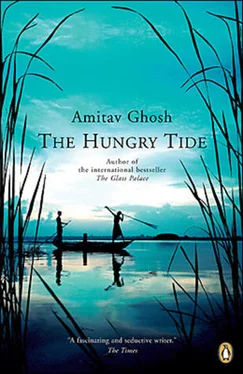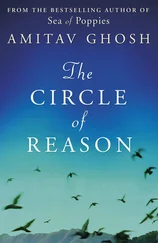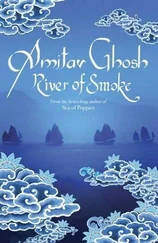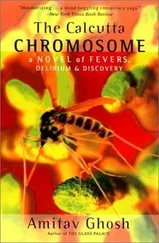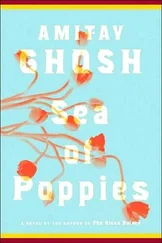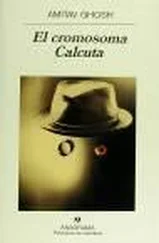Kanai went to sit beside her on the bed. He had been uneasy about broaching the subject of Kusum, but he could see no way around it. “Tell me,” he said gently, “do you think Kusum might have had something to do with it?”
She flinched at the sound of the name. “There were rumors, Kanai. Yes, I won’t deny it.”
“But how did Kusum end up at Morichjhãpi?”
“I don’t know how it happened. But somehow she did.”
“And did you ever see her while she was there?” Kanai said.
Nilima nodded. “Yes. Just once. She came to see me, in this very room.”
She was working at her desk, said Nilima, one morning in 1978, when a nurse came to tell her she had a visitor, someone who claimed to know her. Nilima asked what her name was, but the nurse didn’t know. “All right,” said Nilima. “Bring her here.” A few minutes later the door opened to admit a young woman and a child, a boy of four or five. The woman looked to be in her early twenties but she was dressed in a white sari and there were no bangles on her wrists and no vermilion in her hair: elsewhere, Nilima would have known immediately she was a widow, but in Lusibari she could not be sure.
There was something familiar about the woman — not so much her face as the look in her eye — but Nilima could not remember her name. When the visitor bowed to touch her feet, she said, “Tell me now, who are you?”
“Mashima,” came the answer, “my name is Kusum. Don’t you remember me?”
“Kusum!” Almost at once Nilima began to scold her. “Why didn’t you send news, Kusum? Where have you been? Didn’t you know we were looking for you?”
Kusum’s answer was to laugh. “Mashima, there was too much to tell. More than I could put into a letter.”
When she stood up Nilima saw that Kusum had grown into a sturdy, bright-eyed young woman. “And who is this boy, Kusum?”
“That’s my son,” she answered. “His name is Fokir — Fokirchand Mandol.”
“And his father?”
“His father died, Mashima. I’m all he has now.”
Nilima was glad to see that premature widowhood had not robbed Kusum of her ready laugh. “Tell me, Kusum. What brings you here?”
It was then that Kusum revealed that she was living in Morichjhãpi: she had come to Lusibari in the hope of persuading Nilima to send medical help for the settlers.
Nilima was immediately on her guard. She told her that she would like to help, but it was impossible. The government had made it known that it would stop at nothing to evict the settlers: anyone suspected of helping them was sure to get into trouble. Nilima had the hospital and the Women’s Union to think of: she could not afford to alienate the government. She had to consider the greater good.
After half an hour Kusum left and Nilima never saw her again.
“So what happened after that?” Kanai said. “Where did she go?”
“She didn’t go anywhere, Kanai. She was killed.”
“Killed?” said Kanai. “How? What happened?”
“She died in the massacre, Kanai,” Nilima said. “The massacre at Morichjhãpi.”
She covered her face with her hands. “I’m tired now. I think I’d better rest for a while.”
IN THE AFTERNOON, as the waters began to rise, Piya noticed that she was seeing less and less of the dolphins. This was confirmed by a glance at her data sheets: it seemed the animals had begun to disperse with the turning of the tide.
Through the early hours of the day the pace of Piya’s work had been dictated by the belief that this was a school of migrating dolphins that might depart at any minute. But now she began to wonder: these animals hadn’t given her the impression of being headed anywhere in particular. On the contrary, she had gotten the feeling that they had gathered here to wait out the ebb tide until the water rose again. But that made no sense either, she told herself; it just didn’t fit with what she knew about these animals.
Orcaella were of two kinds: one tribe liked the salt water of the coast while the other preferred rivers and fresh water. The difference between these communities was not anatomical — it had only to do with their choice of habitat. Of the two populations, the coastal was by far the more numerous. The waters of southern Asia and northern Australia were reliably believed to contain several thousand of them. Fresh-water Orcaella, on the other hand, were a rare and dwindling breed. Only a few hundred now remained in Asia’s rivers. Coastal Orcaella were not known to linger for hours in one place and were more likely to range freely along the shore. Their fresh-water cousins were more territorial and not nearly so gregarious. In times of heavy rainfall, when the rivers rose, they would roam far afield, chasing their prey into minor tributaries and even into flooded rice fields. But in dry periods, when the rivers began to drop, they would make their way back to certain spots. These were usually deep-water pools, created by quirks of geology in the riverbed or by the water’s patterns of flow. In Cambodia Piya had tracked populations of Orcaella in several pools along the Mekong, from Phnom Penh to the Laos border. She had found the same individuals returning to the same pools year after year. But when the seasons changed these dolphins traveled hundreds of miles downriver; in one unfortunate instance an animal had swum all the way down from the Laos border only to drown in a gill net near Phnom Penh.
Piya had come to the Sundarbans believing that any Orcaella she found there would be of the coastal variety: this seemed only logical, considering how salty the waters were in this region. But what she had seen today made her wonder if she hadn’t made a mistake. If these were coastal Orcaella what were they doing congregating in a pool? That was out of character for them — only their river-dwelling kin did that. But these could not be river dolphins either. The water was too salty. And anyway, riverine Orcaella didn’t leave their pools in the middle of the day; they spent a whole season in them. So what kind of animal was this and what did this odd behavior mean?
As she mulled over these questions a thought came into Piya’s mind. Was it possible that these Sundarbans Orcaella did twice each day what their Mekong cousins did once every year? Had they found a novel way of adapting their behavior to this tidal ecology? Could it be that they had compressed the annual seasonal rhythms of their Mekong relatives so as to fit them into the daily cycle of tides?
Piya knew that if she could establish any of this she would have a hypothesis of stunning elegance and economy — a thing of beauty rarely found in the messy domain of mammalian behavior. What was more, the idea might well have profound implications for the conservation of this endangered species: protective measures would be much more effective if they could be focused on particular pools and specific movement corridors. But the hypothesis begged as many questions as it answered. What, for instance, were the physiological mechanisms that attuned the animals to the flow of the tides? Obviously, it could not be their circadian rhythms since the timing of the tides changed from day to day. What happened in the monsoon, when the flow of fresh water increased and the balance of salinity changed? Was the daily cycle of migration inscribed on the palimpsest of a longer seasonal rhythm?
Piya remembered a study that had shown there were more species of fish in the Sundarbans than could be found in the whole continent of Europe. This proliferation of aquatic life was thought to be the result of the unusually varied composition of the water itself. The waters of river and sea did not intermingle evenly in this part of the delta; rather, they interpenetrated each other, creating hundreds of different ecological niches, with streams of fresh water running along the floors of some channels, creating variations of salinity and turbidity. These microenvironments were like balloons suspended in the water, and they had their own patterns of flow. They changed position constantly, sometimes floating into midstream and then wafting back toward the shore, at times being carried well out to sea and at others retreating deep inland. Each balloon was a floating biodome filled with endemic fauna and flora, and as they made their way through the waters, strings of predators followed, trailing in their wake. This proliferation of environments was responsible for creating and sustaining a dazzling variety of aquatic life forms — from gargantuan crocodiles to microscopic fish.
Читать дальше
Конец ознакомительного отрывка
Купить книгу
